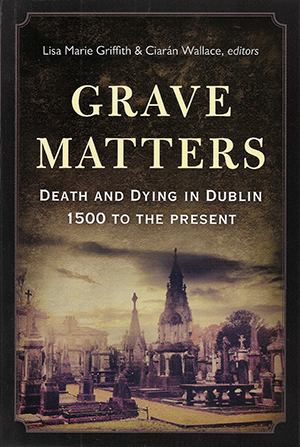Grave matters: death and dying in Dublin 1500 to the present
Published in Book Reviews, Book Reviews, Issue 6 (November/December 2016), Reviews, Volume 24LISA MARIE GRIFFITH and CIARÁN WALLACE (eds)
Four Courts Press
€22.45
ISBN 9781846826016
Reviewed by: Conor Dodd
 This publication originated at a conference of the same name that was organised by the Dublin City Research Group in 2014 and explored various aspects of death and the city in the modern era. As the editors point out, this volume is not, nor is it intended to be, a comprehensive account of death and dying in Dublin over the past 500 years; rather it is a miscellany that seeks to look at the topic in four main themes or stages: dying, death, burial and commemoration. Although its date range covers the period from 1500 to the present day, its contributions for the most part deal with the eighteenth to twentieth centuries.
This publication originated at a conference of the same name that was organised by the Dublin City Research Group in 2014 and explored various aspects of death and the city in the modern era. As the editors point out, this volume is not, nor is it intended to be, a comprehensive account of death and dying in Dublin over the past 500 years; rather it is a miscellany that seeks to look at the topic in four main themes or stages: dying, death, burial and commemoration. Although its date range covers the period from 1500 to the present day, its contributions for the most part deal with the eighteenth to twentieth centuries.
Death as an area of historical study is multi-faceted, covering many disciplines. It is appropriate that the areas of expertise of the contributors reflect this and that many different approaches are taken throughout. There is a particularly unique Irish interest in the idea of death, a topic that can intrigue and intimidate in equal measure. It is suggested that this Irish interest in death can be traced through the very fabric of our nationalism and sense of identity. From the horrors of the Famine period to the martyrdom of revolutionary leaders, death has played a central role in our development as a nation. More generally, in order to understand a city, a society or a country it is important to understand death, its causes, attitudes towards it and how it reflects the social history of a people.
Aside from the central overarching theme of death and dying, two very general threads can be seen running throughout. One is the constant evolution in the process of dying, death, funerary rites and remembrance, and the other is the concept of how death, in its own unique way, can be of use for religious, political or personal purposes.
Advances in medical science, or the age-old attempt to stave off one’s inevitable demise, are explored via a study of puerperal fever at the Rotunda Lying-in Hospital. The histories of St James’s graveyard and burial in eighteenth-century Dublin city and its hinterland detail not only the advancement in the ways people were buried and remembered but also how this reflects the social history of any given period. Changing technology has also affected the way in which the dead are remembered and mourned. The advent of post-mortem portraits in the nineteenth century is explained through the use of two extant examples taken by Dublin photographers, and in a more contemporary sense a new phase of remembrance is examined by looking at Glasnevin Cemetery and Museum.
The examples of the funerals and monuments of Sir Francis Agard and family in the sixteenth century and William Conolly in the eighteenth not only give an understanding of heraldic funerals and the memorials of that period but also show how funerals could have a purpose. Funerals and memorials could be a final statement, consolidating a social status to which a person had not been born or establishing a legacy—a way of showing their contemporaries that they had arrived while on their way out. The eighteenth-century sermons of Gahan, Gallagher and Goonan on death are shown as a gateway to the wider teachings of the Catholic Church at that time and how reminding people of their own mortality and what might yet come could be used to encourage a Christian and virtuous life.
One of the valuable traits of this publication is how many of the contributions vary from the micro to the macro of any given topic. One such example looks at the influenza pandemic of 1918–19 and its impact on the population of Dublin. Book-ended by the final stages of the First World War and the start of the War of Independence, the pandemic has been overshadowed. Nationally, deaths attributed to influenza number over 20,000 in less than a year, although, as the author remarks, this is most probably a conservative estimate. This is equivalent to half the Irish soldiers killed during the First World War. Drawing not only on numbers and statistics, it brings a human face to the tragedy that the flu entailed by exploring the personal stories of some of those who experienced it, such as four members of the Phelan family who were found dead and dying alongside one another at their home.
It is the hope of the editors that this volume will spark further interest in the topic of how Dublin and its population interacted with and experienced death through the centuries. This has certainly been achieved within this publication, which will take its place alongside a growing body of research into an area experiencing increased public interest. It might be most appropriate to look at this book as a modern day memento mori. It reminds us of the transient nature of life, both past and present, aids us in remembering and understanding the life experiences of those who have gone before us, and hopefully will encourage future historians to assume the mantle and do the same.
Conor Dodd is Resident Historian of Glasnevin Trust.
















